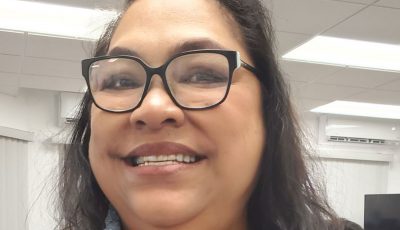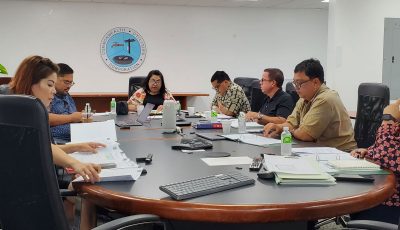CUC: Water loss at 70 percent
Water production down to 84 pct

The Commonwealth Utilities Corp. board and management discussed at length the shortage of water supply on Saipan at a public meeting yesterday. Out of 10 million gallons of water produced every day, CUC has an estimated water loss of 70 percent. (Frauleine Villanueva-Dizon)
A myriad of problems continue to plague water production and distribution of the Commonwealth Utilities Corp. as it continues to address water supply issues in Saipan where round-the-clock water services are still not available to all villages.
During a board meeting yesterday, CUC acting executive director Gary Camacho reported that water production is reduced to 84 percent or about 10 million gallons per day.
“We have a total of 138 wells, 26 are not in service,” Camacho said.
Aside from these wells, CUC has two Maui shaft type wells, one spring, 18 booster pump stations, 17 tanks, and 458 miles of water lines as part of their water production and distribution facilities to 15 tank service areas.
While these seem to produce even more than Saipan’s water demand of 6.5 million gallons per day, water losses or unaccounted for water is currently estimated to be as high as 70 percent, leading to the inability of CUC to supply the needs of island.
“Current water production will be sufficient to meet the calculated demand when water losses are reduced to 37.5 percent,” Camacho said in his report.
CUC’s unaccounted for water comes from leaks, waste, and theft.
According to their water division, they address about 15 leaks per week. About 10 percent of the total pipes of CUC has been resolved due to leaks.
CUC said it has two leak detection units that are addressing the leaks both at the main and service lines. They are in the process of adding more personnel to focus on leaks.
To address supply issues at the source, CUC identified that they need to drill seven wells this year to replace failed wells, which would cost $1,260,000.
“Failure is due to collapsed casing, dropped pumps or pipes in the well, or damaged screens,” Camacho said.
Next year, CUC would need to replace wells on private property or five wells that will amount to $900,000. The following years would see the need to replace three failing wells at $540,000.
“CUC should probably be prepared to replace two to four wells per year,” Camacho added.
Lack of functioning meters
Another pressing issue for the water division is the shortage of functioning meters.
According to CUC board chair Adelina Roberto, about 50 percent of the water customers on island are not properly metered.
It is estimated that less than 100 customers are not metered at all and are paying at a “flat rate”—including some commercial accounts.
Accounts and financial manager Betty Terlaje reported that they have earlier identified a need of 4,000 meters specifically for active accounts.
She added that as about 1,000 meters were already on board, there is a need for 3,000 meters more.
While the lack of functioning meters hinder CUC to actually charge its customers accurately, it also hinders CUC from monitoring actual consumptions. This is also seen as a deterrent for customers to conserve their usage as some can get away with consuming higher than what they pay for.
One discussion made at the board meeting was to re-prioritize grant money to address current pressing issues with the water division.
These grant money, most of which come from the U.S. Environmental Protection Agency, which allocates about $6 million per year, are already set for specific priority projects.
“We had a priority listing, but priorities have changed,” vice chair Eric San Nicolas said.
Camacho reported to the board that they have consulted the matter with EPA, which said that changes to the priority listing can be made with the approval of the Bureau of Environmental and Coastal Quality.
The board will reconvene today for further discussion.



























